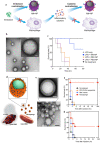Advances in sepsis diagnosis and management: a paradigm shift towards nanotechnology
- PMID: 33413364
- PMCID: PMC7790597
- DOI: 10.1186/s12929-020-00702-6
Advances in sepsis diagnosis and management: a paradigm shift towards nanotechnology
Abstract
Sepsis, a dysregulated immune response due to life-threatening organ dysfunction, caused by drug-resistant pathogens, is a major global health threat contributing to high disease burden. Clinical outcomes in sepsis depend on timely diagnosis and appropriate early therapeutic intervention. There is a growing interest in the evaluation of nanotechnology-based solutions for sepsis management due to the inherent and unique properties of these nano-sized systems. This review presents recent advancements in nanotechnology-based solutions for sepsis diagnosis and management. Development of nanosensors based on electrochemical, immunological or magnetic principals provide highly sensitive, selective and rapid detection of sepsis biomarkers such as procalcitonin and C-reactive protein and are reviewed extensively. Nanoparticle-based drug delivery of antibiotics in sepsis models have shown promising results in combating drug resistance. Surface functionalization with antimicrobial peptides further enhances efficacy by targeting pathogens or specific microenvironments. Various strategies in nanoformulations have demonstrated the ability to deliver antibiotics and anti-inflammatory agents, simultaneously, have been reviewed. The critical role of nanoformulations of other adjuvant therapies including antioxidant, antitoxins and extracorporeal blood purification in sepsis management are also highlighted. Nanodiagnostics and nanotherapeutics in sepsis have enormous potential and provide new perspectives in sepsis management, supported by promising future biomedical applications included in the review.
Keywords: Antimicrobial resistance; Nanodiagnostics; Nanotechnology; Nanotherapeutics; Sepsis.
Conflict of interest statement
The authors declare that they have no competing interests.
Figures







Similar articles
-
Applications of peptides in nanosystems for diagnosing and managing bacterial sepsis.J Biomed Sci. 2024 Apr 19;31(1):40. doi: 10.1186/s12929-024-01029-2. J Biomed Sci. 2024. PMID: 38637839 Free PMC article. Review.
-
Developments and Trends of Nanotechnology Application in Sepsis: A Comprehensive Review Based on Knowledge Visualization Analysis.ACS Nano. 2024 Mar 19;18(11):7711-7738. doi: 10.1021/acsnano.3c10458. Epub 2024 Mar 1. ACS Nano. 2024. PMID: 38427687 Review.
-
Sepsis Care Pathway 2019.Qatar Med J. 2019 Nov 7;2019(2):4. doi: 10.5339/qmj.2019.qccc.4. eCollection 2019. Qatar Med J. 2019. PMID: 31763206 Free PMC article.
-
Nanotechnology Applications in Sepsis: Essential Knowledge for Clinicians.Pharmaceutics. 2023 Jun 8;15(6):1682. doi: 10.3390/pharmaceutics15061682. Pharmaceutics. 2023. PMID: 37376129 Free PMC article. Review.
-
Micro- and nanosensors for detecting blood pathogens and biomarkers at different points of sepsis care.Mikrochim Acta. 2022 Jan 26;189(2):74. doi: 10.1007/s00604-022-05171-2. Mikrochim Acta. 2022. PMID: 35080669 Free PMC article. Review.
Cited by
-
Novel Diagnostics and Therapeutics in Sepsis.Biomedicines. 2021 Mar 18;9(3):311. doi: 10.3390/biomedicines9030311. Biomedicines. 2021. PMID: 33803628 Free PMC article. Review.
-
Enhancing acute inflammatory and sepsis treatment: superiority of membrane receptor blockade.Front Immunol. 2024 Jul 16;15:1424768. doi: 10.3389/fimmu.2024.1424768. eCollection 2024. Front Immunol. 2024. PMID: 39081318 Free PMC article. Review.
-
Evaluation Value of Serum miR-4299 and miR-16-5p in Risk Stratification of Sepsis-Induced Acute Kidney Injury.Biomed Res Int. 2022 Jul 8;2022:5165892. doi: 10.1155/2022/5165892. eCollection 2022. Biomed Res Int. 2022. Retraction in: Biomed Res Int. 2023 Dec 29;2023:9769478. doi: 10.1155/2023/9769478. PMID: 35845963 Free PMC article. Retracted.
-
Beyond anti-inflammatory strategies: addressing immunosuppression with nanomaterials in sepsis treatment.Front Immunol. 2024 Nov 18;15:1500734. doi: 10.3389/fimmu.2024.1500734. eCollection 2024. Front Immunol. 2024. PMID: 39624087 Free PMC article. No abstract available.
-
Lacticaseibacillus rhamnosus TR08 alleviated intestinal injury and modulated microbiota dysbiosis in septic mice.BMC Microbiol. 2021 Sep 18;21(1):249. doi: 10.1186/s12866-021-02317-9. BMC Microbiol. 2021. PMID: 34536996 Free PMC article.
References
-
- WHA. Improving the prevention, diagnosis and clinical management of sepsis. Vol. 140, World Health Organization. https://www.who.int/servicedeliverysafety/areas/sepsis/en/. Accessed 27 Apr 2020.
-
- CDC. Sepsis. https://www.cdc.gov/sepsis/index.html. Accessed on 4 May 2020.
Publication types
MeSH terms
LinkOut - more resources
Full Text Sources
Other Literature Sources
Medical
Research Materials

